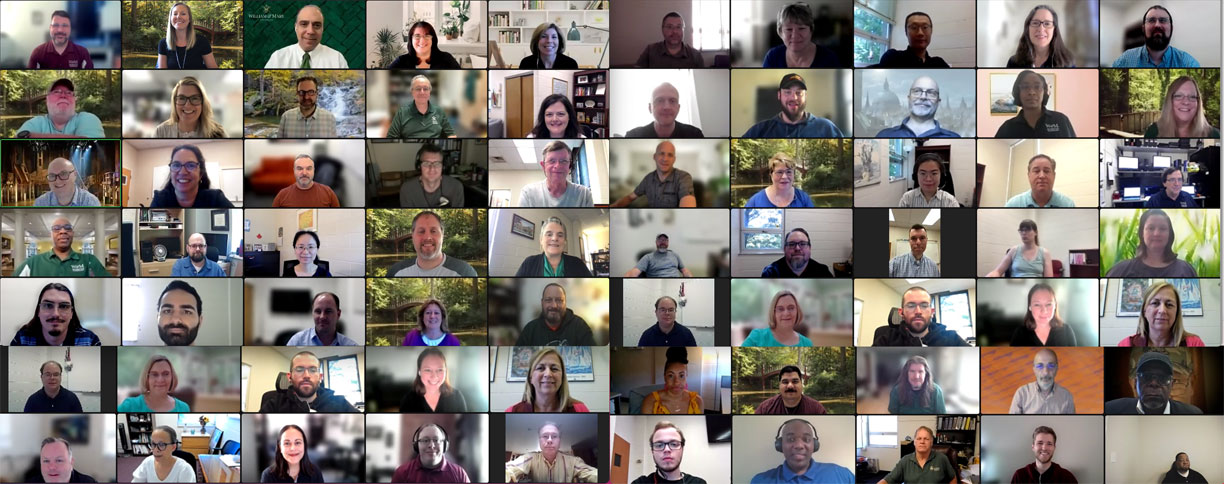Year in Review
2021-2022 Annual Report
It's been a transformative year for William & Mary Information Technology. Explore what we have accomplished over the past year and see what's coming next.

Message from the CIO
As we reflect on the past year, I am proud of the ways our team has continued to move forward amidst the challenges and constant curve balls thrown our way by the pandemic. Having joined the William & Mary community in June 2020, I witnessed firsthand the extraordinary work that was done by our team and our colleagues across campus when responding to COVID. As we look ahead at 2023, we are looking back on the progress and innovations we have made over the course of the past year.

Our Team
For more than two years, our team has continued to provide a reliable, flexible and secure technological environment while working on campus and remotely. While we haven't been able to gather in person for a team photo due to COVID, a Zoom photo perfectly captures what work has been like for the past couple of years.
Points of Interest
-
Mission/Vision/Strategic Goals
W&M IT revised its Mission Statement, Vision and Strategic Goals this year.
-
Staff Recognition
Check out some of the ways our staff has been recognized for their exceptional work this year.
-
What's new?
W&M IT has wrapped up a number of projects this year, as well as added an entirely new unit to the team.
-
Around campus
Big construction projects and new cutting-edge facilities mean a lot of new technology!
-
University & Community Engagement
Browse through some of the opportunities our team members took to engage with our university partners as well as our wider community this year.
IT introduces new governance structure
The W&M IT governance structure was created in 2021 to provide a consultative forum for diverse opinions throughout the university. It is comprised of six advisory committees that relate to specific areas of governance and the overarching IT Advisory Council. Each committee includes representation from within IT, plus faculty, staff, and students so that voices from all corners of the university can be heard.

Vision 2026
Vision 2026, William & Mary's strategic plan, was launched at Charter Day 2022 and details the goals and initiatives we are working towards over the next four years. W&M IT will play an integral role in accomplishing several of the strategic actions for our schools and units. Explore the strategic actions that will require the expertise of team IT.
What's next for 2023?
What's next for IT?
Technology
- Modernizing internal communications
- Creating a more dynamic DocuSign process
- Completing the first phase of Banner cloud migration
- Expanding pervasive WiFi outdoors
- Decentralization of fiber plant to add redundancy
- Replacing end-of-life architecture
- Evaluating effectiveness of CRM
Research
- Acquiring large new homogenous cluster in HPC
- Establishing JupyterHub sites for research computing for easier computing interface
- Acquiring more containers in HPC to enable users to self-serve new software
- Curating of Linux images for users to install on workstations/desktops that will come with important computational packages
- Leverage cloud computing for scientific computational research workload
Security
- Reduce risk of compromised accounts by discontinuing email for alumni and deleting dormant Google Workspace accounts
- Requiring modern authentication for all access to AzureAD, which will discontinue support for older, less secure authentication methods
- Leveraging O365 license by deploying Defender on all servers, begin piloting use of Sentinel for logging and monitoring and begin use of conditional access features
- Enhance end-user security awareness
- Assess and modernize identity management technologies and processes
Data
- Provide excellent Institutional Research services to the whole W&M community, including university leadership, faculty, staff, and students, in an ever more automated, and high-quality manner.
- Develop W&M Data Maturity for all departments from an industry Level1 Initial/Adhoc to Level 2 Repeatable level where Data Governance is emerging, a consistent toolset is introduced, and there is a growing awareness of the impact of data quality issues.
- Build out the Data Governance Advisory Council (DGAC) to include W&M wide, Student and Faculty working teams.
- Expand W&M self-service analytic capabilities; Expand Fact Book interactive and enable Provost and Vision 26 Dashboard(s).
- Improving data quality in W&M operational data stores and analytics with a focus on Banner and major 3rd party systems.
- Building data communities of interest across W&M and improve data fluency.
Client Services & Academic Technology
- Centralizing signage systems and content management across the university
- Standardizing a core set of classroom technologies across all campus classrooms
- Evaluation of the Digital Learning Environment ecosystem
- Deploying technology to support hybrid collaboration in administrative conference rooms
- Exploring chat options that support AI-driven user assistance to provide 24/7 automated support
- Establishing a model for experimenting with new academic technology tools for instructional use
- Streamline the computer imaging process and remote classroom support capabilities
 Skip to main content
Skip to main content
